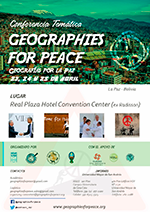Report of the UGI - IGU Thematic Conference “The Geographies of Peace”, Bolivia 2017
DOI:
https://doi.org/10.15381/espiral.v3i5.21277Keywords:
Geographies For Peace, Latin America, War, Thematic Conference, BoliviaAbstract
Geography has generally been accused of being useful especially in waging war. Rather, it can offer a wide range of contributions to peacebuilding and socio-territorial conflict resolution on various national or local scales. The “Geographies for Peace” of 2017 was a thematic conference of the International Geographical Union, whose objective was, if possible, from a transdisciplinary entry, its study, in this sense, from the historical point of view and the role of the activities that socially construct the space of “Peace” such as education, culture, politics, economy or tourism, because for the sociopolitical analysis of war and peace it is necessary to carry out this exercise of measuring power and its impact on the multiscale territory . To make this review or comment of the 2017 event, we consider it very relevant and current due to the situation in the midst of the Covid-19 pandemic on a global and local scale, which is a dispute between the state and the Sars Cov-2 virus of the territory through terror (territory) or territoriality / deterritoriality that reminds us of that liminality between Peace and War. Likewise, it makes us visible the importance of the academic events of the UGI and their influence on the geographical thinking of the countries receiving the event, the antecedents and the conjunctures that occur before, during or after events of these characteristics, possible Legacies and criticisms regarding this academic activity, such as the UGI Bolivia Thematic Conference 2017.

Downloads
Published
Issue
Section
License
Copyright (c) 2021 Juan Manuel Delgado Estrada

This work is licensed under a Creative Commons Attribution 4.0 International License.
LOS AUTORES RETIENEN SUS DERECHOS:
a. Los autores retienen sus derechos de marca y patente, y también sobre cualquier proceso o procedimiento descrito en el artículo.
b. Los autores retienen el derecho de compartir, copiar, distribuir, ejecutar y comunicar públicamente el artículo publicado en la revista Espiral (por ejemplo, colocarlo en un repositorio institucional o publicarlo en un libro), con un reconocimiento de su publicación inicial en la revista Espiral.
c. Los autores retienen el derecho a hacer una posterior publicación de su trabajo, de utilizar el artículo o cualquier parte de aquel (por ejemplo: una compilación de sus trabajos, notas para conferencias, tesis, o para un libro), siempre que indiquen la fuente de publicación (autores del trabajo, revista, volumen, número y fecha).





